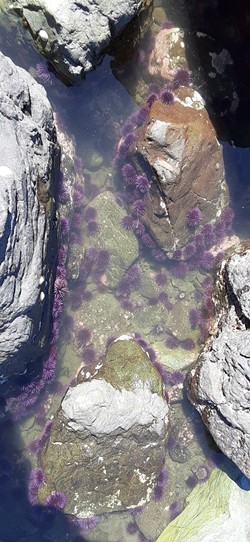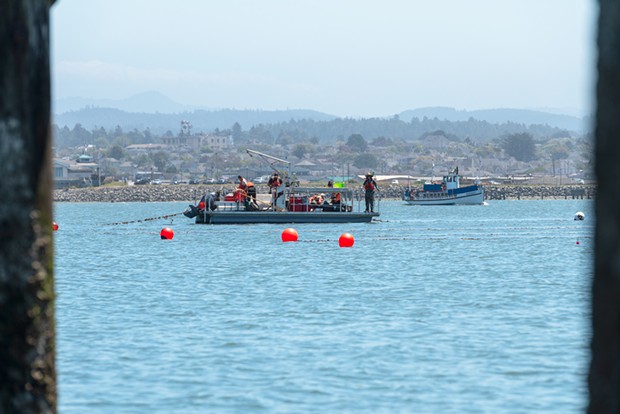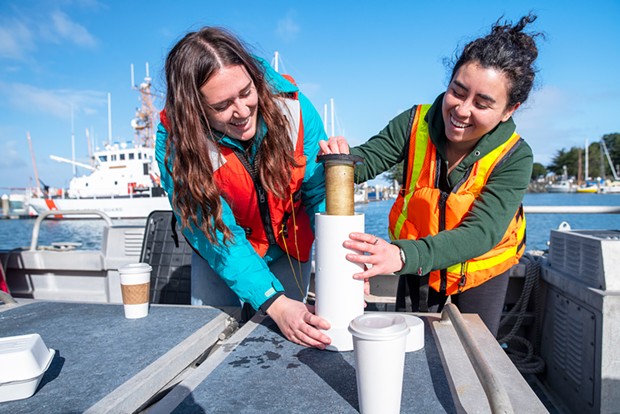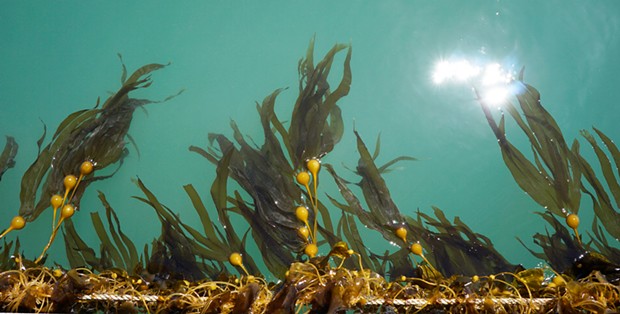Hopes that shuttering the North Coast's recreational red abalone season for five years would be enough to reverse the precipitous decline in the mollusk's population appear to have been overly optimistic. Reopening of the fishery — which seems almost an impossibility any time soon — now depends on a methodical intervention effort to rebuild a complex ocean forest.

- Photo by Grant Eberle
- Purple urchins fill a tidepool in Humboldt County.
An unprecedented series of ecological events wreaked havoc on the North Coast's marine environment over the last decade, unraveling the delicate balance of one of the world's most biodiverse ecosystems.
Wide swaths of bull kelp forest that once brimmed with a dazzling display of marine life evanesced after being weakened by warming ocean waters and stripped bare by marauding armies of purple urchins left newly unfettered by the near extinction of its most voracious predator.
Amid this backdrop, red abalone began to starve on the region's kelp-barren reefs, the slow-moving mollusk simply unable to compete against the spiky urchin hordes' ability to swiftly flitter across the ocean floor in search of food — and their alien-like capacity to go years without eating.
But even without any recreational harvesting, the surveys at six sites found an even bleaker situation than back in 2018, when abalone numbers had plummeted by an estimated 75 percent in the span of just a few years.
"Unfortunately, it's still downhill," Craig Shuman, the California Department of Fish and Wildlife marine region manager, told the commission's Marine Resources Committee in November of the survey results. "We keep thinking we've reached the bottom and every time we come back and realize, 'Whoops, we haven't hit the bottom yet.' How low can we go? I don't necessarily want to answer that question because the bottom is a very scary place to be."
The committee, made up of Fish and Game Commission members, had convened to wrap up outstanding details on a long-awaited plan for managing the North Coast's red abalone, including what benchmarks to use in determining how many could be taken in any given year.
The process, which stalwartly continued forward even as the fishery descended into collapse, was supposed to be reaching a conclusion after nearly nine years, having started when the red abalone population was still healthy and a push was on to relax regulations.

- Courtesy of Cal Poly Humboldt
- A seaweed harvest on Humboldt Bay, with graduate student lead Kalani Ortiz and student volunteers.
But speaker after speaker urged the committee to recommend pushing "the pause button" on developing any new harvest control rules — which are already mired in controversy — and place the focus on recovery for the foreseeable future.
Those speakers included Jack Likins, a formerly staunch opponent of the recreational season's closure, who told the committee the underwater realities have changed his mind.
"We all agree the abalone resources are under a lot of stress, as is the general marine environment," said Likins, who has more than 60 years of seeking out abalone in the North Coast's icy waters under his dive belt. "It will be years, if not a decade, before an abalone fishery like we once enjoyed could be realized, probably even before we could manage a de minimis fishery.
"I'd like to suggest that we take the time that we have — because it's going to take so long for the fishery to recover — to develop and verify a plan we can all agree to and accept."
Any recovery, he noted, hinges on bringing the marine environment back into balance.
"So I'm a big supporter of doing whatever we can do to help the kelp recover, which will in turn not only help the abalone but all the marine species," Likins added.
Ultimately, the committee heeded the pleas, with Shuman saying CDFW staff would go back to do some homework on next steps.
The morbid "bright spot," he said, is that any decision on new harvest control rules "isn't going to matter for 10 to 15 years."
Committee member Erik Sklar agreed, saying there was no rush to move forward.
"Unfortunately, until the stocks go up, we are going to extend the closure," he said. "I think that's just a given."
The so-called "perfect storm" of climate-driven calamities in North Coast waters dates back to August of 2011, when Sonoma County saw a massive die-off of marine life amid an outbreak of toxic algae.

- Photo courtesy of Cal Poly Humboldt
- Marzia Fattori and Kalani Ortiz on Humboldt Bay with kelp starts.
Two years later, a mysterious wasting disease wiped out an estimated 80 percent of sea stars up and down the Pacific Coast, especially devastating the sunflower star — one of the largest sea stars in the world, with a full-accompaniment of 24 arms at maturity, that's capable of gobbling a sea urchin whole — which is now on the brink of extinction.
Without one of its main predators, purple sea urchin populations exploded just as back-to-back marine heat waves — the so-called "warm water blob" of 2014 and the "Godzilla" El Niño of 2015 — hit.
Those thrust the region's bull kelp forests — dependent on cool ocean temperatures to thrive — into distress, with some areas off the Mendocino and Sonoma coasts seeing declines of more than 90 percent compared to previous years.
According to the summer survey results presented to the Marine Resources Committee, along with the lowest density of abalone ever observed at the six sites studied, the areas still show large numbers of urchins and low-levels of bull kelp, despite more favorable ocean conditions having returned to the region in 2021.
Complicating recovery is the slow-to-grow nature of abalone, which take years to reach maturity. Additionally, the way the shellfish reproduce by sending sperm and eggs out into the water, requires dense populations for a successful match to be made.
Bull kelp presents a similar scenario.
Unlike its southern cousin the giant kelp, bull kelp grows as a single stalk and dies off each year — basically an annual marine plant rather than a perennial — making it more vulnerable to urchin intrusions that can inhibit new growth's ability to gain a foothold.
A series of cooperative efforts are underway to give Mother Nature a helping hand, bringing together a network of stakeholders, from scientists and government agencies to commercial urchin divers and nonprofits, to create a restoration plan.
Among those is a project down in Fort Bragg's Noyo Harbor — which has seen a resurgence of bull kelp at restoration sites after teams of commercial divers, working in conjunction with scientists, culled urchin\ levels down to a very succinct number of two per square meter, the threshold anticipated to give fledgling kelp blades a fighting chance at survival.
Others include a partnership between the University of Washington and The Nature Conservancy, which has successfully reared young sunflower stars in captivity, with the hope of releasing them into the wild.
"What we're attempting to do here is to raise a new generation of sea stars in the lab," Jason Hodin, a Friday Harbor Lab research scientist leading the project, said in a 2021 university announcement on the project. "We're hoping that our efforts can help in the process of recovery of the sunflower sea star and, ultimately, recovery of the health of ecosystems like the kelp forests that are under threat right now."
Cal Poly Humboldt programs are also playing a role, not only in the recovery efforts but in conducting research needed to better understand the complex inner workings of the bull kelp ecosystem.
"It's a huge ecological disaster," said zoology and marine biology professor Sean Craig, who specializes in applied ecology of Marine Protected Areas and invertebrate zoology. "So it's a problem that's going to take a lot of scientists and a lot of collaboration and, unfortunately, it's going to take some time for us to even just understand better what happened and how things are going to change with future heat waves, as well as what can we do about all of this."

- Photo by Kalani Ortiz
- Bull kelp being farmed in Humboldt Bay.
To that end, Craig and a team of graduate students are joining researchers from University of California at Davis and UC Santa Cruz to study sites at the mouths of the Big, Albion and Navarro rivers in Mendocino County, where patches of bull kelp appear to have held their ground.
The project includes plans to deploy instruments to measure salinity levels and water temperatures this summer, as well as lay out underwater transects and quadrats to count kelp and record marine life in sample areas.
"We have some evidence already that suggests that there are remnant refuge populations of kelp near the mouths of rivers," Craig said. "So we are turning our attention research-wise to try to figure out why they are doing well at those sites, and our leading hypothesis is the freshwater may be limiting the grazing of urchins enough to keep the kelp beds going there."
The working theory, he said, is those might be good places to concentrate restoration efforts.
"We don't really know why kelp are still in some patches and have disappeared from other sites," Craig said. "We need to learn more and, of course, we need to find some areas, I would say, that we can expand upon, that we can begin to outplant kelp and begin to hopefully recover our kelp beds, so that's why we are focusing on these river output sites."
Ideally, he said, any restoration should be concentrated where "you think there's a better chance they will stay," noting the practice of replanting kelp "is still very much in its infancy."
That's where the commercial seaweed farm the CPH Fisheries Department is operating off Humboldt Bay can come into play, even if its inclusion was originally unintentional.
CPH started the living laboratory to research best practices and give students hands-on training in the up-and-coming industry by producing dulse seaweed, a native to the area that can be used in everything from fertilizer to food, providing a low-impact crop that doesn't need added nutrients or fresh water to grow.
But when bull kelp started showing up in the lines, the pilot project added the keystone species to the mix, developing technology to raise bull kelp in a nursery at the university's marine lab in Trinidad before transferring young blades out to the open ocean farm.
The project is now at the forefront of efforts to learn how to generate a stock of kelp that can be transplanted in recovery efforts. It's trying to answer key questions, including what materials bull kelp grows best on and the maximum water temperature bull kelp can tolerate as well as how transplant depth affects growth. In addition to guiding replanting efforts, the research also may provide insight into how the bull kelp will fare in the future amid increasingly dire climate crisis forecasts.
So far, Humboldt County has weathered the storm better than areas to the south, said CPH graduate student Franklin Moitoza, who has surveyed MPAs from the Oregon border to Mendocino border and is part of the three rivers project.
While researchers haven't gathered official data on Trinidad's kelp beds since 2020, recent dives in the harbor area showed urchins have "cleared some spots but it's not widespread barren," he said.
And, Moitoza said, "we have seen a much higher abundance of red abalone in Trinidad than we've seen in the past," with most appearing to be in a similar size class, noting the local area's population has always been a bit patchy compared to a traditionally more widespread distribution on the Sonoma and Mendocino coasts, which made those areas more of a draw when recreational seasons were still open.
The work in Mendocino, he said, is also hoped to shed some light on the bull kelp forests' capacity for resilience, including how the ecosystem might be able to withstand singular stressors, like a marine heatwave, as opposed to the virtual kitchen-sink of ecological entanglements that have hit in recent years.
"If only one of those events happened, would it have the same effect?" Moitoza asked.
Like architects of the sea, Craig said kelp beds are often referred to as "ecosystem engineers" in reference to the underwater worlds created as single tendrils stretch up to the ocean surface to lay out a waxy canopy, providing both a sanctuary and the nutrients that other species — from sponges and crustaceans to abalone and lingcod — need to thrive.
"The blades are slowing down the ... water flow," Craig said. "They are entraining larvae to settle. They are creating nooks and crannies of habitat. They are supplying food. And all of those things that a kelp bed does quite literally creates a much, much more rich habitat and enhances local fisheries. Many of the rock fishes that are caught, the young are literally growing up in those kelp forests."
The "elephant in the room," Craig said, is: How often will these marine heatwaves hit the North Coast.
To preserve and conserve these unique coastal environments, he noted, the importance of healthy bull kelp forests cannot be overstated.
Moitoza agreed, adding that the kelp forests also play a critical environmental role by sequestering carbon at rates that even outpace the rainforest.
"The kelp is as essential as the Joshua Tree is to the desert, as the redwood trees are to our temperate rainforest, as oak trees are to the valleys, hills and grasslands,'' he said. "It's essential. And we notice the issues we're having on land ... but so much of what's happening in the ocean is out of sight.
"That's why we need to make sure we put a lot of energy into better understanding and protecting that system, the kelp system, as we do protecting the forests and grasslands on land."
Kimberly Wear (she/her) is the digital editor at the Journal. Reach her at (707) 442-1400, extension 323, or [email protected]. Follow her on Twitter @kimberly_wear.
Comments
Showing 1-1 of 1